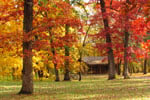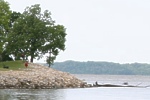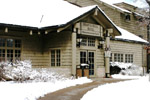JOHNSON SAUK TRAIL STATE PARK
From cross-country skiing in the winter to a lazy picnic in the summer, from a fishing trip in the spring to exploring fields of wildflowers amidst the fall colors of the giant oaks, Johnson-Sauk Trail State Park truly is a park for all seasons.
Located on a glacial moraine that forms the beautiful, rolling hills of Henry County in north-central Illinois, the park sits astride a trail that led Native Americans from Lake Michigan to the confluence of the Mississippi and Rock rivers.
Located off Illinois Route 78, Johnson-Sauk Trail is 6 miles south of Interstate 80 and 5 miles north of Kewanee. Originally known as the Henry County Conservation Area, a local newspaper invited the public to suggest names when the conservation area was going to be changed to a state park. Two names were popular with the public. One would name the park after State Senator Frank P. Johnson, a tireless worker on behalf of the park, while the second suggested Sauk Trail as a fitting name, for the Indian tribes most associated with the park when Europeans began settling the area.
The two most popular choices were combined to form the park's official name. Today, Johnson-Sauk Trail State Park features 1,365 acres of recreation opportunities.
Johnson-Sauk Trail State Park features a varied terrain, with rolling hills covered with a mix of hardwoods and pines in the south half of the park, and a flatter landscape with wildlife plantings and grasslands making up the northern half of the park.
The park's centerpiece is a 58-acre lake that offers both fishing and boating, as well as nearly two and a half miles of shoreline to explore.
The lake was one of a series of lakes considered for Illinois in 1944. After studying a number of sites, 369 acres of land known as Whiting's Woods were purchased. Actual construction of the lake didn't begin until 1949, and was halted soon after when engineers encountered unfavorable soil conditions. Work didn't get underway again until the summer of 1955, after advanced methods of dam construction were developed.
The park also has Sauk Trail Pond, a scenic 3-acre pond near the park's round barn, that provides fishing opportunities in a more restful setting.
From spring through fall, visitors will find a wide array of both woodland and prairie wildflowers, including bluebells, Dutchman's breeches, trillium, prairie anemone, yarrow, field daisies, vervain and goldenrod.
While fewer than 1,000 natural areas exist in Illinois, one of them is located in Johnson-Sauk Trail State Park. The area contains a population of skunk cabbage, an early bloomer that sometimes blossoms in the snow -- rare for this part of the state.
White-tailed deer, raccoons, squirrel, opossum and rabbits are among the myriad wildlife found in the park, while birders have ample opportunities to catch sight of chickadees, nuthatches, goldfinches and hundreds of other avian visitors.
Johnson-Sauk Trail State Park is located in a part of Illinois that was a vast shallow sea millions of years ago. Two glaciers covered this part of Illinois, the last being the Wisconsinian Glacier, which shaped the land as we know it today.
The state park is located on the southern edge of what once was the Great Willow Swamp, a marsh area covering the low-lying areas between the Mississippi, Rock and Green rivers, and is believed to have contained one of the most concentrated and varied wildlife populations in the central part of North America.
Attracting large numbers of both market and sport hunters, the area was considered a sportsman's paradise. The marsh eventually was drained for agricultural purposes.
The abundance of wild game and fur-bearing animals was what attracted Indians -- the area's first inhabitants -- to this part of Illinois. Although mound-building tribes were the first Native Americans to settle this part of the state, tribes of Sauk, Fox, Winnebago, Kickapoo, Potawatomi, Kaskaskia, Peoria and Piankashaw Indians later established villages here.
Winnebago Indians are known to have used the Sauk Trail and to have camped at or near the state park regularly. The Sauk tribe moved from Wisconsin to the confluence of the Rock and Mississippi rivers and joined the Fox Indians to form a confederation. These tribes sent hunting parties to this part of the marsh frequently.
French trappers and traders were the first Europeans to pass through this area. The land encompassing Johnson-Sauk Trail State Park was part of the Great Northwest Territory claimed by France. Following the French and Indian War, the land was ceded to Great Britain in 1765, becoming part of the colony of Virginia. The land later was part of the Northwest Territory and Illinois Territory before Illinois gained statehood.
Day-UseFishingyes
Huntingyes
Hiking Trailyes
Swimming Beachyes
Bike Trailsyes
BoatingLaunch Rampsyes
CampingPrimitiveyes
Electric Sitesyes
WinterActivitiesyes
The seasonal Marina offers rental boats, sell fishing bait and supplies, food and beverage, souvenirs and camping supplies. The upper deck of the Marina offers a full menu restaurant.
The Chief Keokuk Campground features 71 pads with electrical hook-ups for trailers (Class A camping), plus 25 tent sites (Class C camping). There is a shower building on site. A sanitary dump station is near the camping area. In addition, "Blackhawk" area on Lakeshore Loop Road is available for youth group camping.





